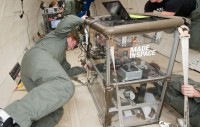
The 3D printer being tested in microgravity conditions at NASA’s Marshall Space Flight Center. Credit: nasa.gov
NASA and Made In Space achieve first 3D printed object to be produced in space on-board International Space Station (ISS).
Dezeen.com reported that the first 3D printed object has been produced on-board the ISS, with NASA stating that the achievement is “paving the way to future long-term space expeditions”.
Following NASA’s decision to fund California-based business Made In Space to develop 3D printing technology for use in space, the printer was installed on the ISS by astronaut Barry Wilmore on 17 November and began printing the object – a faceplate for the printer’s own casing – on 24 November; following commands sent from NASA ground controllers. The achievement demonstrates that 3D printers are able to produce their own replacement parts whilst in space.
Niki Werkheiser, Project Manager for the ISS 3D Printer at NASA’s Marshall Space Flight Center in Alabama, commented: “This first print is the initial step toward providing an on-demand machine shop capability away from Earth […] the space station is the only laboratory where we can fully test this technology in space.
“If a printer is critical for explorers, it must be capable of replicating its own parts, so that it can keep working during longer journeys to places like Mars or an asteroid […] ultimately, one day, a printer may even be able to print another printer.”
Upon inspection of the printed part it was found that it “had partially stuck to its tray”, which the NASA team suggests means that “the bonding of the layers of plastic might be different in microgravity”; with the printer working by “extruding plastic filament that has been heated at a low temperature to melt it” and then printing the plastic in layers.
As a result, the team installed a new printer tray and sent new printing instructions to the machine; and it is planned that the first objects printed in space will be sent down to Earth “to be compared to control samples” on order to “see if there are any differences between the printing quality” in microgravity and ground conditions.
Werkheiser said: “This is the first time we’ve ever used a 3D printer in space, and we are learning, even from these initial operations […] as we print more parts we’ll be able to learn whether some of the effects we are seeing are caused by microgravity or just part of the normal fine-tuning process for printing. When we get the parts back on Earth, we’ll be able to do a more detailed analysis to find out how they compare to parts printed on Earth.”
Aaron Kemmer, CEO of Made In Space, said: “The operation of the 3D printer is a transformative moment in space development […] we’ve built a machine that will provide us with research data needed to develop future 3D printers for the ISS and beyond, revolutionising space manufacturing. This may change how we approach getting replacement tools and parts to the space station crew, allowing them to be less reliant on supply missions from Earth.”
You can read more about 3D printing in space in Issue 263’s wide-format column on page 54.
